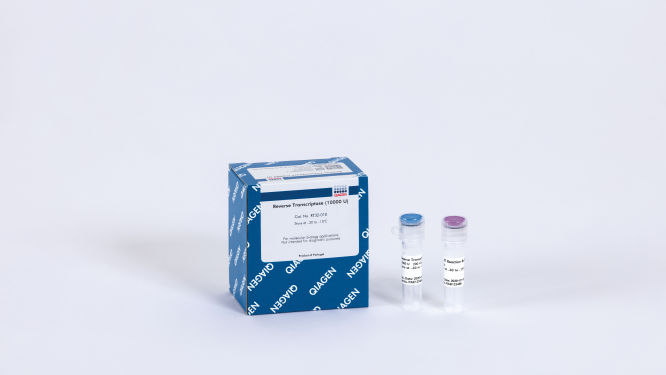Reverse Transcriptase (10,000 U)
Cat. No. / ID: RT32-010
Features
- Yields high full-length cDNA synthesis (up to 7 kb)
- Possesses increased sensitivity in RT-qPCR and RT-PCR assays
- Shows no RNase H or 3’→5’ exonuclease activity
- Has supreme thermostability and is suitable for complex RNA templates
Product Details
Reverse Transcriptase is a modified, recombinant form of the Reverse Transcriptase from the Moloney Murine Leukemia Virus (M-MuLV) purified from Escherichia coli. Reverse Transcriptase synthesizes a complementary DNA strand in the presence of a primer using either RNA (cDNA synthesis) or single-stranded DNA (ssDNA) as a template.
Reverse Transcriptase has increased thermal stability, which allows the reaction to be carried out at a higher temperature (optimum activity at 50°C).
It is supplied with 10x RT Reaction Buffer containing 500 Tris-HCl (pH 8.3), 750 mM KCl, 30 mM MgCl2, 100 mM DTT.
One unit is defined as the amount of enzyme required to incorporate 1 nmol of dTTP into an acid-insoluble material in 10 minutes at 37°C, using poly(A) x oligo(dT)12-18 as template primer.
Performance
| Assay | Specification |
|---|---|
| Purity | >90% |
| DNase contamination | None detected |
| RNase contamination | None detected |
Principle
It increases the efficiency and specificity of those transcribed RNA regions rich in GC pairs and containing secondary structures. The enzyme has no 3’ – 5’ exonuclease or RNase H activity, which improves the synthesis of a full-length cDNA, even from long mRNA templates, using random priming. The enzyme gives high yields of first-strand cDNA synthesis up to 7 kb long.
Working with RNA
Acquiring high-quality, intact RNA, free of genomic DNA and RNase traces, is vital for synthesizing a full-length cDNA followed by an accurate quantitative analysis (qPCR).
The following recommendations should be followed:
- Maintain aseptic working conditions by using disposable gloves and changing them as frequently as required; use RNase-free consumables; only work in an area assigned for working with RNA and with equipment designated for that purpose.
- dsDNase HL enzyme (not included) may be used if obtaining a DNA-free RNA sample is required.
- RNA samples should be stored aliquoted at -70°C. Avoid subjecting the samples to repeated freezing and thawing cycles.
Additional information
During RT-PCR preparation, keep Reverse Transcriptase and 10x RT Reaction Buffer on ice or in a freezing rack.
Use an RNase H treatment for reactions sensitive to residue RNA traces to increase the sensitivity of RT-qPCR.
The quantity of cDNA used when preparing PCR or qPCR reactions should not exceed 1/10 of a final reaction volume; e.g., a maximum volume of 2.5 µL of cDNA should be used in a 25 µL reaction.
Metal ion chelating agents inhibit the activity of Reverse Transcriptase (e.g., EDTA), inorganic phosphors, pyrophosphates and polyamines.
Enzyme inactivation should be carried out at 85°C for 5 minutes.
Procedure
Quality Control
Protein purity is determined using assay by SDS-PAGE electrophoresis resulting in >90% purity.
RNase and DNase contamination is evaluated by assessing RNase and DNase activity. In addition, functional quality is tested by RT-PCR experiment.
Applications
This is used for applications such as:
- Full-length cDNA template synthesis for RT-qPCR and two-step RT-PCR assays
- cDNA synthesis for molecular cloning
- cDNA library construction
- RNA analysis

